**The Significance of Cosmos Flowers in Creating a Sustainable and Thriving Environment for Future Generations**

Cosmos flowers, with their enchanting beauty and ecological benefits, play a crucial role in fostering a sustainable and flourishing environment for generations to come. As versatile and resilient plants, cosmos flowers contribute to ecosystem health, biodiversity conservation, and climate resilience, making them valuable allies in our quest for a sustainable future. In this comprehensive discussion, we delve into the importance of cosmos flowers in creating a habitat that supports life, promotes well-being, and safeguards the planet for future generations.
**1. Biodiversity Enhancement:**
Cosmos flowers are champions of biodiversity, attracting a diverse array of pollinators, beneficial insects, and wildlife to their blooms. By providing nectar and pollen sources for bees, butterflies, and other pollinators, cosmos flowers support the reproductive success of flowering plants and contribute to ecosystem resilience. Their presence in gardens, meadows, and natural habitats enhances species diversity and strengthens ecological networks, ensuring the vitality and adaptability of ecosystems for future generations.
**2. Soil Health and Erosion Control:**
The extensive root systems of cosmos flowers help improve soil structure, prevent erosion, and promote soil health. By anchoring soil particles and enhancing water retention, cosmos flowers play a vital role in soil stabilization and erosion control, particularly in areas prone to land degradation and desertification. Healthy soils enriched by cosmos flowers provide a fertile foundation for plant growth, water filtration, and nutrient cycling, supporting agricultural productivity and ecosystem sustainability for future generations.
**3. Climate Resilience and Adaptation:**
Cosmos flowers contribute to climate resilience and adaptation by sequestering carbon, mitigating climate extremes, and enhancing ecosystem stability. As carbon-fixing plants, cosmos flowers help mitigate climate change by absorbing carbon dioxide from the atmosphere and storing it in their biomass and soil. Additionally, their ability to thrive in diverse climatic conditions makes them valuable assets in climate-smart landscaping and reforestation efforts, where they contribute to habitat restoration, carbon sequestration, and microclimate regulation.
**4. Education and Environmental Awareness:**
Cosmos flowers serve as ambassadors for environmental education and awareness, inspiring future generations to appreciate and protect the natural world. Through school gardens, nature trails, and environmental education programs, children and youth learn about the importance of biodiversity conservation, sustainable agriculture, and ecosystem stewardship. Cosmos flowers provide hands-on learning experiences that foster curiosity, empathy, and environmental literacy, empowering young people to become responsible custodians of the planet.
**5. Community Engagement and Green Spaces:**
Cosmos flowers create opportunities for community engagement and green space development, enriching urban and rural landscapes with their beauty and ecological value. Community gardens, parks, and green corridors adorned with cosmos flowers provide accessible and inclusive spaces for recreation, relaxation, and social interaction. Engaging communities in cosmos flower planting projects, conservation initiatives, and eco-tourism activities fosters a sense of ownership, pride, and collective responsibility for preserving nature’s bounty for future generations.
**6. Sustainable Land Use Practices:**
Incorporating cosmos flowers into sustainable land use practices promotes land stewardship, agroecology, and regenerative agriculture for future generations. Integrating cosmos flowers into agroforestry systems, crop rotations, and cover cropping regimens enhances soil fertility, pest management, and crop resilience. Their role as beneficial companion plants and habitat enhancers supports agroecological principles such as biodiversity conservation, soil conservation, and water management, ensuring the long-term viability of agricultural landscapes.
**7. Ethical Consumption and Conservation Advocacy:**
Embracing ethical consumption practices and advocating for conservation measures are essential for safeguarding cosmos flowers and their habitats for future generations. Choosing sustainably sourced products, supporting eco-friendly businesses, and reducing resource consumption contribute to biodiversity conservation and ecosystem protection. Conservation advocacy efforts aimed at habitat preservation, species protection, and policy reform raise awareness about the importance of cosmos flowers and their role in creating a sustainable future for all.
**8. Conclusion:**
In conclusion, cosmos flowers play a vital role in creating a sustainable and thriving environment for future generations by enhancing biodiversity, promoting soil health, and fostering climate resilience. Through education, community engagement, and sustainable land use practices, we can harness the power of cosmos flowers to nurture ecosystems, inspire stewardship, and leave a legacy of environmental harmony for generations to come. By valuing and protecting cosmos flowers, we invest in a brighter and more sustainable future for our planet and all its inhabitants.








